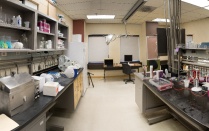IN THE NEWS
Sun Young Kang & Jack Tseng

Human’s place in the evolutionary tree of life
The definition of ‘human’ has been explored by generations of philosophers, biologists, geneticists, and anatomists through books, paintings, film, and others forms of expression. What has always been a minor voice in this discussion is the broader context of the evolutionary roots of our lineage, or our place in the group of mammals called primates. This project is an artist-anatomist collaboration to explore human’s place in the broader tree of life, with time as a central theme in understanding human and evolutionary history.
The art of paper-making is one of human civilization’s earliest inventions. Paper-making technology permitted the collective human experience to be systematically recorded. Paper also exemplifies one of the quintessential characteristics of human civilization: the modification of our natural environment for the benefit of our own species via the cultural inheritance of technology and experience. During their time in residence, Sun Young Kang and Jack Tseng will focus on telling this human evolution story with paper as the canvas for visualizing human’s place in space and time.
Sun Young Kang
Sun Young Kang is a book and installation artist. Originally from South Korea, Kang resided in Philadelphia and Pittsburgh, PA for a decade and currently she is in Buffalo, NY. From small intimate books to room size installations, she uses paper with its duality of strength and delicacy to create physical and conceptual space. Kang received her MFA in Book Arts/Printmaking from the University of the Arts in Philadelphia, PA in 2007, and BFA in Korean Painting from Ewha Woman’s University in Seoul, Korea.
Kang is a recipient of Pollock-Krasner Foundation Grant Award, 2017-2018, New York Foundation for Arts Artist Fellowship (NYSCA/NYFA Artist Fellowship) in Architecture/ Environmental Structures/ Design, 2019, Vermont Studio Center Fellowship, 2019 and Center for the Emerging Visual Artists Fellowship in Philadelphia from 2013 to 2015 and a participant in the Diplomatic Art 2015, the 2013 Sofia International Paper Art Biennale, and the Pittsburgh Biennial 2008. Her work has been included in numerous solo and group exhibitions nationally and internationally at venues including Whanki Museum, Seoul Korea, Queens Museum, NY, Whatcom Museum, WA, Carnegie Museum of Arts, Pennsylvania State Museum, the Susquehanna Art Museum, PA, Pittsburgh Center for the Arts, Mainline Art Center and Philadelphia Art Alliance, PA. Her work is also included in the Pennsylvania State Museum permanent collection, Museum of Modern Art Franklin Furnace Artist book collection, and in numerous libraries’ special collections.
Jack Tseng
http://medicine.buffalo.edu/content/medicine/faculty/profile.html?ubit=jacktsen
I am an integrative and evolutionary biologist, and my research focuses on the quantitative and functional anatomy and evolution of the mammalian craniodental system. Research in my laboratory is focused on the macroevolutionary-scale patterns of structure-function relationships in mammals and other vertebrate groups. My model system of choice is the skull of carnivoramorphan mammals (dogs, cats, bears, hyenas and their living and extinct relatives). Despite the suggestion of a meat-eating lifestyle implied by the name of this mammal group, living carnivoramorphan species include not only specialists of vertebrate soft tissues, but others that are adapted to feed on insects, plants, fruits--or even bones. Projects in my lab include analysis of important variables such as diet, evolutionary relationships and non-masticatory functional constraints and their interplay on the structure and function of the skull as a feeding tool. I use methodologies such as landmark-based shape analysis (geometric morphometrics), model-based assessments of feeding performance (finite element analysis) as well as experiment-based model validation approaches and field-based and collection-based research on extinct mammal groups.

